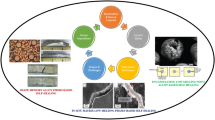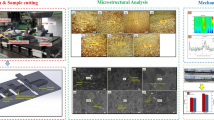Abstract
We investigated the healing of epoxy resins with embedded ethyl phenylacetate (EPA) solvent loaded capsules and shape memory alloy (SMA) wires under fatigue loading in tapered double cantilever beam (TDCB) mode. Under cyclic loading, the kinetics of solvent diffusion are in competition with the rate of damage propagation. We showed that the active mechanism of self-healing under continuous loading is different from that in quasi-static testing. Crack arrest was observed after some initial crack growth, resulting from the diffusion of EPA solvent into the crack tip, involving local plasticization of the epoxy. Finite element analysis confirmed that the lower modulus and higher elongation at break of the solvated epoxy reduced the stresses at the crack tip. This effect combined with the well-studied microcapsule toughening effect, tremendously increased the toughness of plain epoxy. For epoxy with embedded SMA wires, completely fractured samples, healed using SMA activation, showed similar fatigue resistance as virgin samples. Furthermore, SMA activation during a 10 min break also stabilized crack progression, compared to at least 2 h needed to reach the same effect without SMA wires.












Similar content being viewed by others
References
White SR, Sottos NR, Geubelle PH, Moore JS, Kessler MR, Sriram SR, Brown EN, Viswanathan S (2001) Autonomic healing of polymer composites. Nature 409(6822):794–797
Chen X, Dam MA, Ono K, Mal A, Shen H, Nutt SR, Sheran K, Wudl F (2002) A thermally re-mendable cross-linked polymeric material. Science 295(5560):1698–1702
Hayes SA, Jones FR, Marshiya K, Zhang W (2007) A self-healing thermosetting composite material. Compos A Appl Sci Manuf 38(4):1116–1120
Bergman SD, Wudl F (2008) Mendable polymers. J Mater Chem 18(1):41–62
Berl V, Schmutz M, Krische MJ, Khoury RG, Lehn JM (2002) Supramolecular polymers generated from heterocomplementary monomers linked through multiple hydrogen-bonding arrays - formation, characterization, and properties. Chem Eur J 8(5):1227–1244
Kalista SJ, Ward TC, Oyetunji Z (2007) Self-healing of poly(ethylene-co-methacrylic acid) copolymers following projectile puncture. Mech Adv Mater Struct 14(5):391–397
Chen X, Wudl F, Mal AK, Shen H, Nutt SR (2003) New thermally remendable highly cross-linked polymeric materials. Macromolecules 36(6):1802–1807
Caruso MM, Delafuente DA, Ho V, Sottos NR, Moore JS, White SR (2007) Solvent-promoted self-healing epoxy materials. Macromolecules 40(25):8830–8832
Yan CY, Min ZR, Ming QZ, Chen J, Gui CY, Xue ML (2008) Self-healing polymeric materials using epoxy/mercaptan as the healant. Macromolecules 41(14):5197–5202
Williams G, Trask R, Bond I (2007) A self-healing carbon fibre reinforced polymer for aerospace applications. Compos A Appl Sci Manuf 38(6):1525–1532
Toohey KS, Sottos NR, Lewis JA, Moore JS, White SR (2007) Self-healing materials with microvascular networks. Nat Mater 6(8):581–585
Williams HR, Trask RS, Weaver PM, Bond IP (2008) Minimum mass vascular networks in multifunctional materials. J R Soc Interface 5(18):55–65
Blaiszik BJ, Kramer SLB, Olugebefola SC, Moore JS, Sottos NR, White SR (2010) Self-healing polymers and composites. Annu Rev Mater Res 40(1):179–211
Kirkby E, de Oliveira R, Michaud V, Månson JA (2011) Impact localisation with fbg for a self-healing carbon fibre composite structure. Compos Struct 94(1):8–14
Kessler SS, Spearing SM, Soutis C (2002) Damage detection in composite materials using lamb wave methods. Smart Mater Struct 11(2):269–278
Kirkby EL, Rule JD, Michaud VJ, Sottos NR, White SR, Månson JAE (2008) Embedded shape-memory alloy wires for improved performance of self-healing polymers. Adv Funct Mater 18(15):2253–2260
Park JS, Takahashi K, Guo Z, Wang Y, Bolanos E, Hamann-Schaffner C, Murphy E, Wudl F, Hahn HT (2008) Towards development of a self-healing composite using a mendable polymer and resistive heating. J Compos Mater 42(26):2869–2881
van der Zwaag S, Schmets AJM (2007) Self healing materials : an alternative approach to 20 centuries of materials science. Springer, Dordrecht
Kirkby EL, Michaud VJ, Månson JAE, Sottos NR, White SR (2009) Performance of self-healing epoxy with microencapsulated healing agent and shape memory alloy wires. Polymer 50(23):5533–5538
Neuser S, Michaud V, White SR (2012) Improving solvent-based self-healing materials through shape memory alloys. Polymer 53(2):370–378
Yuan YC, Rong MZ, Zhang MQ, Yang GC (2009) Study of factors related to performance improvement of self-healing epoxy based on dual encapsulated healant. Polymer 50(24):5771–5781
Toohey KS, Hansen CJ, Lewis JA, White SR, Sottos NR (2009) Delivery of two-part self-healing chemistry via microvascular networks. Adv Funct Mater 19(9):1399–1405
Caruso MM, Blaiszik BJ, White SR, Sottos NR, Moore JS (2008) Full recovery of fracture toughness using a nontoxic solvent-based self-healing system. Adv Funct Mater 18(13):1898–1904
Weisenberger LA, Koenig JL (1990) Nmr imaging of diffusion processes in polymers: measurement of the spatial dependence of solvent mobility in partially swollen pmma rods. Macromolecules 23(9):2445–2453
Dutheillet Y, Mantle M, Vesely D, Gladden L (1999) Diffusion of water-acetic acid mixtures in epoxy. J Polym Sci B Polym Phys 37(23):3328–3336
Hamilton AR, Sottos NR, White SR (2012) Mitigation of fatigue damage in self-healing vascular materials. Polymer 53(24):5575–5581
Brown EN, White SR, Sottos NR (2005) Retardation and repair of fatigue cracks in a microcapsule toughened epoxy composite - part i: manual infiltration. Compos Sci Technol 65(15–16):2466–2473
Brown EN, White SR, Sottos NR (2005) Retardation and repair of fatigue cracks in a microcapsule toughened epoxy composite–part II: in situ self-healing. Compos Sci Technol 65(15–16):2474–2480
Brown EN, White SR, Sottos NR (2006) Fatigue crack propagation in microcapsule-toughened epoxy. J Mater Sci 41(19):6266–6273
Shin CS, Huang KC, Li RZ (1998) Artificial retardation of fatigue crack growth by the infiltration of cracks by foreign materials. Fatigue Fract Mater Struct 21(7):835–846
Caruso MM (2010) Solvent-based self-healing polymeric materials. PhD thesis, University of Illinois
Neuser S, Michaud V (2013) Effect of aging on the performance of solvent-based self-healing materials. Polym Chem. doi:10.1039/C3PY00064H
Blaiszik BJ, Caruso MM, McIlroy DA, Moore JS, White SR, Sottos NR (2009) Microcapsules filled with reactive solutions for self-healing materials. Polymer 50(4):990–997
Jones AS, Rule JD, Moore JS, White SR, Sottos NR (2006) Catalyst morphology and dissolution kinetics of self-healing polymers. Chem Mater 18(5):1312–1317
Rule JD, Brown EN, Sottos NR, White SR, Moore JS (2005) Wax-protected catalyst microspheres for efficient self-healing materials. Adv Mater 17(2):205–208
Beres W, Koul AK, Thamburaj R (1997) A tapered double-cantilever-beam specimen designed for constant-k testing at elevated temperatures. J Test Eval 25(6):536–542
Brown EN (2011) Use of the tapered double-cantilever beam geometry for fracture toughness measurements and its application to the quantification of self-healing. Journal Strain Anal Eng Des 46(3):167–186
Brown EN, Sottos NR, White SR (2002) Fracture testing of a self-healing polymer composite. Exp Mech 42(4):372–379
Paris P, Erdogan F (1963) A critical analysis of crack propagation laws. J Basic Eng 85(4):528–534
Moy P, Karasz FE (1980) Epoxy-water interactions. Polym Eng Sci 20(4):315–319
Jones AS, Rule JD, Moore JS, Sottos NR, White SR (2007) Life extension of self-healing polymers with rapidly growing fatigue cracks. J R Soc Interface 4(13):395–403
ANSYS Inc http://www.ansys.com/. Accessed 7 Apr 2012
Acknowledgments
The authors gratefully acknowledge the financial support of the Swiss National Science Foundation (FNRS 511482), the Laboratory of Applied Mechanics and Reliability Analysis (LMAF) at EPFL for using their fatigue testing device and M. G. Sahini, E. Rotterman and S. Clerc for their technical assistance.
Author information
Authors and Affiliations
Corresponding author
Rights and permissions
About this article
Cite this article
Neuser, S., Michaud, V. Fatigue Response of Solvent-Based Self-Healing Smart Materials. Exp Mech 54, 293–304 (2014). https://doi.org/10.1007/s11340-013-9787-5
Received:
Accepted:
Published:
Issue Date:
DOI: https://doi.org/10.1007/s11340-013-9787-5




